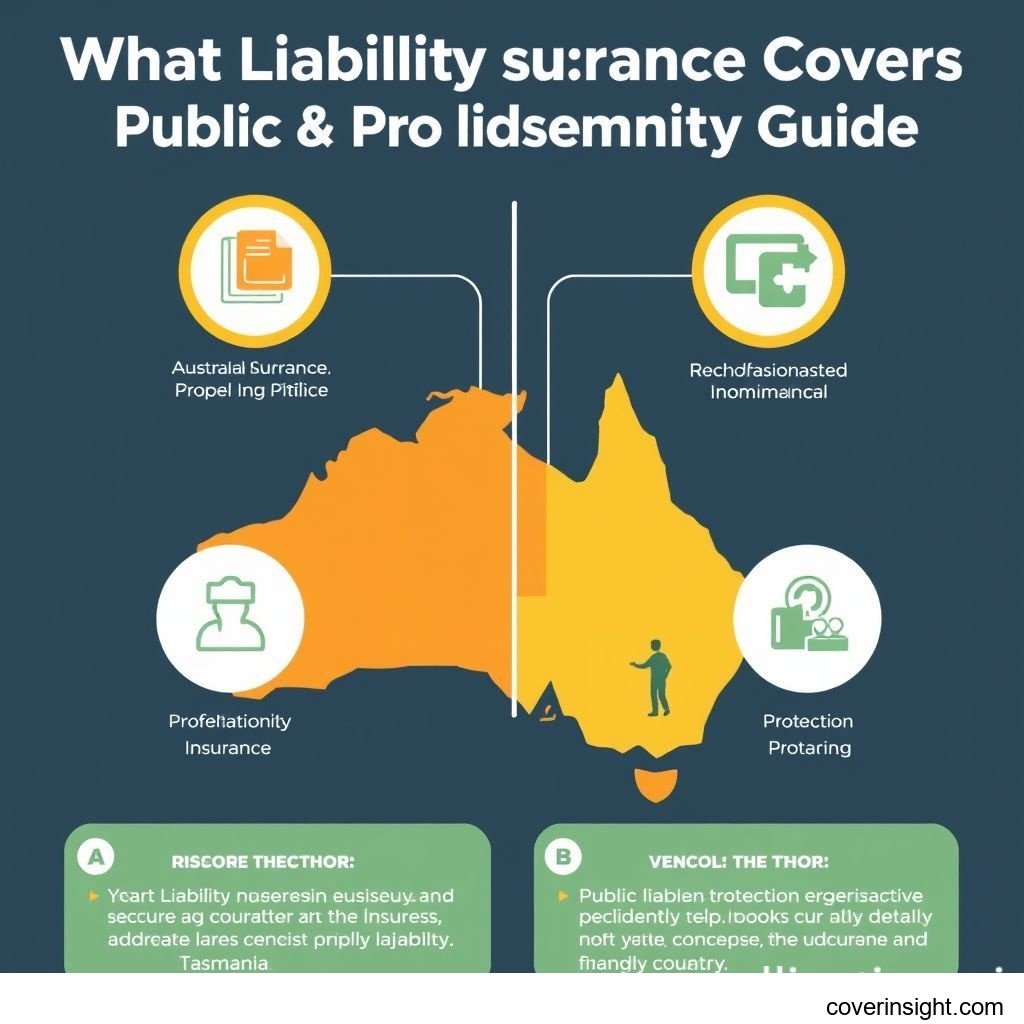Introduction
As Australia continues its dynamic economic growth into 2025, understanding and securing appropriate business protection becomes paramount. For businesses and individuals operating in Tasmania, navigating the complexities of public liability insurance Tasmania is not just a regulatory consideration but a critical safeguard. This guide aims to demystify what liability insurance covers, focusing on both public liability and professional indemnity, offering a comprehensive overview tailored for the Australian context in the coming year. Whether you're a small business owner, a sole trader, or a large corporation, ensuring you have robust coverage is essential for mitigating financial risks and maintaining operational continuity.
Understanding Public & Professional Indemnity in AU 2025
The landscape of business risk is ever-evolving. In 2025, Australian businesses face distinct challenges, making specific types of liability insurance indispensable. Primarily, public liability insurance Tasmania protects against claims for injury or property damage caused to third parties by your business activities. Complementary to this is professional indemnity insurance, which covers financial losses incurred by clients due to your professional advice or services. These two pillars of protection form the bedrock of a secure business operation.
What Liability Insurance Covers: Public Liability Inclusions
Public liability insurance is designed to protect your business from the financial burden of legal costs and compensation claims if a third party is injured or their property is damaged as a result of your business operations. For businesses, including those requiring public liability insurance Tasmania, this coverage is vital.
Here's what public liability insurance typically includes:
-
Third-Party Personal Injury: Covers medical expenses, rehabilitation, and loss of income if a customer, supplier, or member of the public is injured on your premises or due to your operations.
-
Third-Party Property Damage: Financial protection if your business activities cause damage to someone else’s property.
-
Legal Defence Costs: Covers the legal fees incurred in defending a claim, whether or not the claim is ultimately successful.
-
Death or Disease: Protection against claims arising from death or illness caused by your business activities.
-
Advertising Injury: Sometimes includes coverage for claims arising from libel, slander, or copyright infringement in your advertising.
For instance, a tradesperson with public liability insurance Tasmania would be covered if a ladder fell and damaged a client's fence, or if a customer slipped on a wet floor in their shop and sustained an injury. Understanding what liability insurance covers in detail helps businesses tailor their protection.
Common Exclusions in Public Liability Policies
While robust, public liability insurance does not cover every potential risk. It’s crucial for businesses seeking public liability insurance Tasmania to understand these limitations.
Typical exclusions often include:
-
Professional Negligence: This is covered by professional indemnity insurance, not public liability.
-
Employee Injuries: Work-related injuries to employees are covered by Workers' Compensation insurance.
-
Property of the Insured: Damage to your own business property or assets is covered by property insurance.
-
Contractual Liability: Liabilities assumed under a contract that would not exist otherwise.
-
Faulty Workmanship/Products: Claims arising directly from the poor quality of your work or products (often covered by separate product liability or specific warranties).
-
Pure Financial Loss: Losses that don't involve personal injury or property damage.
-
Cyber Risks: Data breaches or cyber attacks are typically covered by cyber insurance.
It's always recommended to review the Product Disclosure Statement (PDS) carefully to understand the specific terms and conditions of your public liability insurance Tasmania policy.
Professional Indemnity: What It Covers
Beyond general third-party risks, professional indemnity insurance is crucial for businesses that provide advice, services, or designs. It protects you against claims of financial loss caused by an error, omission, or negligent act in your professional services.
Professional indemnity typically covers:
-
Breach of Duty: Covers claims arising from a breach of professional duty of care.
-
Misleading Advice: Protection if a client suffers a financial loss due to advice you provided.
-
Errors or Omissions: Financial protection for mistakes or oversights in your work.
-
Copyright Infringement: Claims related to the unintended use of copyrighted material.
-
Defamation: Covers legal costs and damages if you're accused of libel or slander in your professional capacity.
This coverage is vital for consultants, architects, IT professionals, marketing agencies, and anyone whose core service involves intellectual expertise. For many professionals, understanding what liability insurance covers beyond public liability is a necessity for complete protection.
Navigating Contractor Liability Requirements in AU 2025
For independent contractors and subcontractors across Australia, including those operating in Tasmania, understanding contractor liability requirements is non-negotiable. Many principal contractors or clients will mandate specific insurance coverages before engaging your services.
Specific Requirements for Contractors
The precise contractor liability requirements can vary significantly based on industry, project scale, and state regulations. However, general expectations include:
-
Public Liability Insurance: Almost universally required, often with minimum coverage limits (e.g., $5 million, $10 million, or $20 million). This protects against claims arising from your work on site.
-
Professional Indemnity Insurance: Essential for contractors offering design, advisory, or consulting services.
-
Workers' Compensation Insurance: If you employ staff, this is mandatory in all Australian states and territories.
-
Product Liability Insurance: Relevant if you supply products that could cause injury or damage.
Before commencing any contract, always review the client's insurance clauses. Failing to meet contractor liability requirements can lead to contract termination, legal disputes, or significant financial penalties. Securing adequate public liability insurance Tasmania is often the first step for contractors.
Industry-Specific Needs
Different industries have distinct liability profiles and, consequently, unique insurance needs.
Considerations for various sectors:
-
Construction & Trades: High public liability risk due to on-site work. High public liability insurance Tasmania limits are common.
-
IT & Consulting: High professional indemnity risk due to advice and data handling.
-
Healthcare: Specialised medical malpractice and professional indemnity.
-
Cleaning Services: High public liability risk for property damage or slip-and-fall incidents.
-
Event Management: Specific event liability coverage needed alongside public liability.
Understanding these nuances ensures that your public liability insurance Tasmania and other policies are truly fit for purpose, covering the unique risks your business faces.
Cost Analysis: Public Liability Insurance Tasmania
The cost of public liability insurance Tasmania, like any insurance, is not a fixed price. It varies based on a multitude of factors, reflecting the unique risk profile of each business. Getting an accurate quote requires providing detailed information about your operations.
Price Factors for Public & Professional Indemnity
Several key factors influence the premium you'll pay for public and professional indemnity insurance:
-
Industry & Business Activity: High-risk industries (e.g., construction, demolition, adventure tourism) will pay more than low-risk ones (e.g., consulting, retail).
-
Turnover/Revenue: Generally, higher revenue indicates a larger business and potentially greater exposure, leading to higher premiums.
-
Number of Employees: More employees can mean a greater chance of an incident occurring.
-
Coverage Limit: The higher the sum insured (e.g., $5 million vs. $20 million), the higher the premium.
-
Claims History: Businesses with a history of claims may face higher premiums.
-
Location: While public liability insurance Tasmania is specific, metropolitan areas might have different risk profiles than rural ones.
-
Years in Business: Established businesses with a good track record might receive more favourable rates.
-
Excess Amount: Choosing a higher excess (the amount you pay out-of-pocket for a claim) can reduce your premium.
For many, understanding these variables is key to assessing what liability insurance covers relative to its cost.
Saving Tips for Your Policy
While cost is a factor, compromising on essential coverage is ill-advised. However, there are smart ways to potentially reduce your public liability insurance Tasmania premiums without sacrificing protection.
Here are some tips:
-
Bundle Policies: Many insurers offer discounts when you combine multiple policies, such as public liability with professional indemnity, property, or cyber insurance.
-
Implement Risk Management: Proactive measures like robust safety protocols, staff training, and quality control can demonstrate lower risk to insurers.
-
Review Your Sum Insured: Ensure your coverage limit is appropriate for your actual risk, avoiding over-insurance.
-
Increase Your Excess: If you have the financial capacity, opting for a higher excess can lower your upfront premium.
-
Shop Around: Obtain quotes from multiple reputable insurers. The market is competitive, and prices can vary. Using comparison sites or brokers can simplify this process.
-
Annual Payment: Paying annually instead of monthly can sometimes result in a small discount.
-
Maintain a Good Claims History: Avoiding claims, where possible, through diligent operation, will benefit your premiums in the long run.
Choosing the Right Public Liability Insurance Tasmania Policy
Selecting the appropriate public liability insurance Tasmania policy involves more than just comparing prices. It requires a clear understanding of your business's unique risks and future needs.
Assessing Your Needs
Before approaching insurers, conduct a thorough risk assessment of your business. This involves identifying potential scenarios where a third party could be injured or suffer property damage due to your operations.
Consider these questions:
-
Do clients visit your premises?
-
Do you work on client sites or public property?
-
Do your operations involve heavy machinery, chemicals, or other hazardous materials?
-
What is the maximum potential damage or injury your business could realistically cause?
-
Are you required by contract or industry body to hold a certain level of public liability insurance Tasmania?
-
Do you provide any professional advice or services that could lead to financial loss for a client? (This points to Professional Indemnity).
A clear understanding of your operational footprint and contractual contractor liability requirements will guide you towards the correct coverage level and type.
Getting Quotes & Comparing Providers
Once you've assessed your needs, it's time to get quotes. Don't settle for the first offer.
Follow these steps:
-
Gather Information: Have all your business details ready (ABN, turnover, employee numbers, detailed description of services/products, claims history).
-
Contact Multiple Insurers/Brokers: Reach out directly to insurers known for business liability, or use an experienced insurance broker. Brokers can offer valuable advice and access a wider range of policies.
-
Compare Like-for-Like: Ensure you are comparing policies with similar coverage limits, exclusions, and excesses. A cheaper premium might come with significant gaps in coverage.
-
Read the PDS: Always review the Product Disclosure Statement to understand exactly what liability insurance covers, what it excludes, and any specific conditions. Pay attention to the fine print.
-
Check Insurer Reputation: Opt for financially stable and reputable insurers with good claims handling records. The Australian Prudential Regulation Authority (APRA) oversees these institutions, ensuring their stability.
Making an informed decision about your public liability insurance Tasmania is an investment in your business's future security.
FAQs
How much does public liability insurance Tasmania cost?
The cost of public liability insurance Tasmania varies significantly based on your industry, business size, annual turnover, claims history, and the level of coverage you choose (e.g., $5 million, $10 million, or $20 million). High-risk businesses like construction or heavy manufacturing will generally pay more than low-risk businesses like consultants or retail stores. It's essential to get a tailored quote for your specific business.
What affects premiums?
Premiums are influenced by several factors: your industry's inherent risk level, your business's annual revenue and number of employees, the sum insured (the maximum payout amount), your past claims history, and the excess (deductible) you choose. Implementing strong risk management practices can also positively influence your premium.
Is it mandatory?
Public liability insurance Tasmania is not universally mandatory by law for all businesses in Australia. However, it is often a contractual requirement imposed by clients, landlords, or licensing bodies, especially for contractors, tradespeople, or businesses operating in public spaces. While not legally compulsory for every entity, operating without it is a significant financial risk.
How to choose?
To choose the right policy, first assess your business's specific risks and potential liabilities. Consider your industry, the nature of your work, whether you interact with the public, and any contractual contractor liability requirements. Get multiple quotes, compare coverage limits, excesses, and exclusions, and always read the Product Disclosure Statement (PDS) carefully. Consulting an insurance broker can also provide expert guidance. For additional guidance, explore resources on Insurance Resources Global.
Consequences of no coverage?
Operating without adequate liability insurance can lead to severe financial consequences. If a third party is injured or suffers property damage due to your business activities and you are found liable, you would be personally responsible for all compensation costs, legal fees, and court expenses. This could result in significant debt, asset forfeiture, and even bankruptcy, potentially forcing your business to cease operations. It’s a risk few businesses can afford to take. For broader information on Australian insurance, visit AU Insurance Home. You can also find more information from the Insurance Council of Australia.







Comments